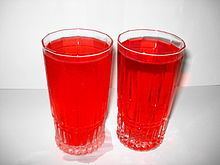 | ||
Similar Baklava, Halva, Basbousa, Sorbet, Qurabiya | ||
Muharram special doodh ka sharbat recipe video how to make hyderabadi muharram special milk juice
Sharbat or sherbet ([ʃərbət̪]) is a popular West and South Asian drink prepared from fruits or flower petals. It is sweet and usually served chilled. It can be served in concentrate form and eaten with a spoon or diluted with water to create the drink. Popular sharbats are made of one or more of the following: basil seeds, rose water, sandalwood, bael, gurhal (hibiscus), lemon, orange, mango, pineapple, falsa (Grewia asiatica), and chia seeds.
Contents
- Muharram special doodh ka sharbat recipe video how to make hyderabadi muharram special milk juice
- Nimbu pudina sharbat recipe mint juice sherbet mint lemonade
- Etymology
- History
- In Turkey
- References
Sharbats are common in Indian, Turkish, Iranian, Bosnian, Arab, Afghan, Pakistani, and Bangladeshi homes, and are popularly consumed by Muslims when breaking their daily fast during the month of Ramadan.
Nimbu pudina sharbat recipe mint juice sherbet mint lemonade
Etymology
The word Sharbat is from Persian "شربت" "sharbat", and Sherbet is from Turkish "şerbet" "sherbet", both of which in turn come from Arabic شربة "sharba" a drink, from شرب "shariba" to drink. Also called "sorbet", which comes from French "sorbet", from Italian "sorbetto", and in turn from Turkish "şerbet". The word is cognate to syrup in British and American English. Historically it was a cool effervescent or iced fruit soft drink. The meaning, spelling, and pronunciation have fractured between different countries. It is usually spelled "sherbet", but a common corruption changes this to "sherbert".
History
In the 12th century, Persian book of Zakhireye Khwarazmshahi, Gorgani describes different types of Sharbats in Iran, including Ghoore, Anar, Sekanjebin, etc.
It was popularised in the Indian subcontinent by Babur, who sent for frequent loads of ice from the Himalayas to make a cool refreshing drink.
In the gardens of the Ottoman Palace, spices and fruits to be used in sherbet were grown under the control of pharmacists and doctors of the Palace.
In Turkey
The person responsible for preparing and serving şerbet in Turkey is called a sherbetji (Turkish: şerbetçi). Some serbetci sell sharbat on the street in the traditional way. On their backs they carry a big brass flask with a long nozzle (called an ibrik) and hold glasses in their sash or brass cup-holders. They serve sharbat by bending forward and filling a glass from the nozzle curved over their shoulder. The Şerbetçi family name is derived from this occupation. In rural areas of Eastern Turkey, the groom's family comes to the bride's house after the dowry is agreed upon and brings an ibrik with sharbat for the future bride to drink as a sign of acceptance of the groom.
From the Ottoman Empire, the edible form of sharbat also spread into the Balkan area, especially in Romania, where it is known as şerbet.
